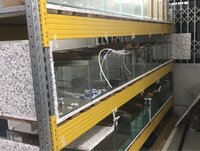dean
Member
Hi all
So I’ve been setting up the discus system for a friend
Yes the usual bare bottom boring tanks
All 28 of them total of 2384 litres
Each tank is going to have a 300 watt heater in it
I know in uk I can wire 10 of these together onto a 13amp plug (max 3 kw) using 1.5 mm2 cable
My question is how to make it neat, tidy, safe and be able to replace one heater easily if required
But the worst bit is this
Cheap as possible he’s at the end of his budget and if he goes over it he won’t need to pay for a sex change his wife will do it for free
he’s at the end of his budget and if he goes over it he won’t need to pay for a sex change his wife will do it for free 
There are 3 tiers to the system
10 tanks on top and middle and 8 wider ones for growing out on the bottom
So I’m thinking of putting each row on it’s own 13amp plug and using chocolate blocks every so often but can’t think of how to make it splash proof but easily accessible
So over to you clever folk for your ideas
Sent from my iPhone using Tapatalk

They are all 3ft long and are end on using industrial racking
So from the front you are looking through what should be a side panel
Sent from my iPhone using Tapatalk
So I’ve been setting up the discus system for a friend
Yes the usual bare bottom boring tanks
All 28 of them total of 2384 litres
Each tank is going to have a 300 watt heater in it
I know in uk I can wire 10 of these together onto a 13amp plug (max 3 kw) using 1.5 mm2 cable
My question is how to make it neat, tidy, safe and be able to replace one heater easily if required
But the worst bit is this
Cheap as possible
 he’s at the end of his budget and if he goes over it he won’t need to pay for a sex change his wife will do it for free
he’s at the end of his budget and if he goes over it he won’t need to pay for a sex change his wife will do it for free 
There are 3 tiers to the system
10 tanks on top and middle and 8 wider ones for growing out on the bottom
So I’m thinking of putting each row on it’s own 13amp plug and using chocolate blocks every so often but can’t think of how to make it splash proof but easily accessible
So over to you clever folk for your ideas

Sent from my iPhone using Tapatalk

They are all 3ft long and are end on using industrial racking
So from the front you are looking through what should be a side panel
Sent from my iPhone using Tapatalk
Last edited by a moderator:


